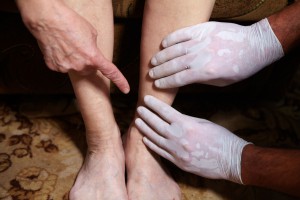Examination and Investigation
Examination and investigation of a patient presenting with possible restless legs should first seek to confirm the diagnosis using the diagnostic criteria. Once established secondary causes should be ruled out. The patient should be asked about other symptoms, medication, alcohol, caffeine and chocolate consumption. A neurological and musculoskeletal examination of the affected parts should be carried out, as well as a generalised neurological assessment (for Parkinsonism and MS). The circulation should be assessed to exclude peripheral vascular disease. These parameters are likely to be normal in idiopathic restless legs syndrome.
The severity of the symptoms can be assessed using this validated patient symptom self-rating scale from the IRLSSG.
Differential diagnoses to be aware of:-

- Cramp – A good history should distinguish restless legs from nocturnal cramp. Cramp is likely to be unilateral, of sudden onset and relieved by stretching rather than repeated movements.
- DVT – Symptoms more likely to be of short duration and accompanied by physical signs of “rubor, dulor, calor and tumor”, the classic signs of inflammation (redness, pain, heat and swelling)
- Peripheral vascular disease – Claudication is more likely to occur with exercise. Careful history and assessment of the peripheral pulses should help with the assessment
- Neuropathy – peripheral neuropathy and nerve root compression can co-exist with restless legs
- Akathisia – A condition where the person feels an inner restlessness, they feel unable to sit still and feel the need to move multiple parts of their body (eg crossing and uncrossing legs, folding arms, orofacial dyskinesia etc.). This condition is often associated with the initiation (or increase in dosage) of an antipsychotic medication or the withdrawal of an anticholinergic.
- Painful legs and moving toes – A rare condition however there is no urge to move in this disorder
NICE’s Clinical Knowledge Summary recommends the following:-
- There are no investigations to confirm the diagnosis of restless legs syndrome (RLS)
- Measure serum ferritin in all people with RLS as anaemia is not a sufficiently sensitive marker for iron deficiency which may precipitate or exacerbate RLS
- Consider other investigations guided by the history and examination (such as renal function, full blood count, thyroid function, blood glucose, vitamin B12), to exclude secondary causes of RLS
- Consider referring to a sleep clinic (if available) if you suspect a sleep disorder, and there is doubt about the diagnosis of RLS. Tests such as polysomnography can help to differentiate RLS from true sleep disorders

